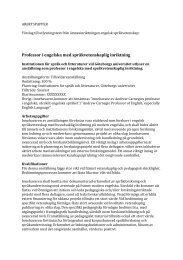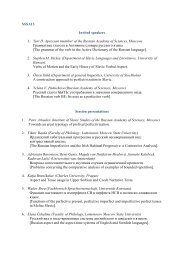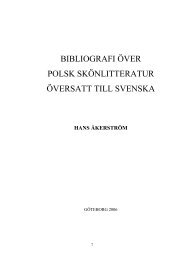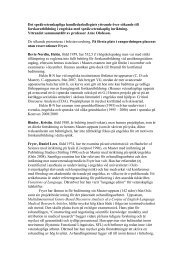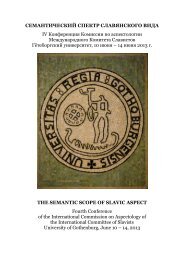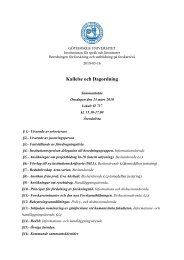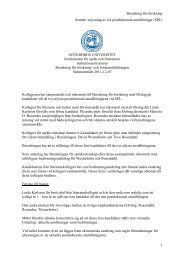China in ancient times, Japan was able to learn about the culture and thought of the leading westernpowers through translation.Contemporary Japanese scholars, such as Maruyama Masao (1914-1996) Katô Shuichî (1919-2008), in their book entitled “Honyaku to Nihon no kindai”, /Translation and Japanese Modernity”(1998) also discuss the intellectual history of translation in Japan. Honyaku to Nihon no kindaiis a published dialogue (taidan) between the two auta popular genre in Japan. The Americanresearcher Andre Haag’s paper, “Maruyama Masao and Katô Shuichi on Translation and JapaneseModernity” (2008) has made a valuable contribution in the dissemination of their ideas to Englishspeaking scholars. The main questions that Maruyama and Katô deal with are:What was the historical context of modern translation in Japan, and how did Japan´s foreignrelations in the late Edo and Meji period determine the course of translation? What kinds of textswere translated? Why did Japanese embrace translation as a means of learning about the world?And why was priority given to translating every available text? (Haag, 2008: 15-16)Theoretical framework.The theoretical framework of this paper is based in the theories of German functionalists (Reissand Vermeer, 1991; Nord, 1997), who consider translation to be a purposeful activity and thatthe translation skopos refers to the goal of the translation process, which may not coincide withthe function of the source text (Schäffner, 2009: 120). Evidence of the skopos can be found in thetexts as well as in paratextual elements.We have also used Widdowson’s concepts of Text, Pretext and Context (2004). wherein discourseis interpreted in the interaction between text and context, “What interpretation involvesis the relating of the language in the text to the schematic constructs of knowledge, belief and soon outside the text. In this way discourse is achieved” (2004: 61). Widdowson’s notion of pretextis related to that of skopos, it is an ulterior motive or a discourse purpose, “The meaning ofwords in texts is always subordinated to a discourse purpose: we read into them what we wantto get out of them (ibid: 86). Also useful for our analysis is the concept of the translators’ visibility(Venuti, 1995), and the theories of the Manipulation School (Hermans, 1985; Lefevere 1992;Bassnett and Lefevere, 1990, Toury, 1995) who focus on the analysis of translation between distantcultures and languages and stress the influence of ideology on translation. Culture is definedfollowing Katan (1999/2003), who highlights the bonds between culture and translation and theimportance of the translator as a cultural mediator. Orientalism (Said, 1978) and the Nihonjinronmovement (Guarnè, 2006) are also useful concepts with which to study the images of Japanthat the authors/translators (Nitobe and Okakura) would like to present to the West in the twoSTs, and the TTs analysed in this paper. Finally, the concept of self- translation (Tanqueiro, 1999,2000, 2007), is used to describe these two authors/translators.General contextThe end of the 19th century and the beginning of the 20th century were characterized by themilitary, nationalist propaganda which influenced the construction of the modern state in Japan.During this period of time Japan was not fully part of the Western world and it was necessaryThe reception of Ethical and Aesthetical Values of Japanese Culture in the West43
to discuss what role Japan was to play in the international community. “In this nationalist andimperialist context, the Japanese used the concept of Yamato Damashii, or “the Soul of Japan”, torepresent all those qualities and traditions that made up their national identity. Theories aboutthe essence of Japanese identity traits were developed within the Nihonjinron movement, andtwo of the most important books published in this tradition at the Meiji Era were written originallyin English by Japanese authors. One of these was Nitobe’s Bushido: the Soul of Japan (1900).The other was The Book of Tea by Okakura Kakuzô (1906).” (Beeby and Rodríguez, in press)Nitobe and Okakura belonged to the élite who were key witnesses to the spectacular modernizationthat took place in Japan during the years following the Meiji Restoration (1868-1912).Both authors used English, not their mother tongue, as a vehicular language to write their bookson Japanese culture. Despite the absence of a previous text in Japanese to be self-translated,both cases could be considered “mental translations” (Tanqueiro, 2000; Neunzig and Tanqueiro,2007), i.e., the process by which the authors/translators reinterpret the product (the text andspecially its cultural references) in English aimed at the Anglophone readers.These books were soon popular in the West, and to a certain extent considered prestigiousworks. Although originally written for Western readers, they were later translated into Japaneseand read by Japanese who, in their majority might have agreed to be represented abroad by the“images of their culture” constructed by Nitobe and Okakura.1. Nitobe´s Bushido the Soul of Japan: the introduction of the Way of Samurai to the West.Nitobe’s Bushido is an example of “Self-translation” and “<strong>Cultural</strong> translation”. The author wasa Japanese diplomat and scholar from a samurai family. He came to be Under Secretary of theLeague of Nations (1920-26) and married Mary Elkintorff, an American quaker. Nitobe’s bookwas written in 1899 and first published in 1900. In the preface, he pointed out that his purpose(skopos) was to explain Japanese culture to the West through the tradition of Bushido, the idealcode of morals and conduct of the Samurai nurtured by Oriental wisdom and religion. This wasin fact a great effort of intercultural mediation and one of the first attempts to explain Japanesecultural traits to the rest of the world (Beeby and Rodríguez, 2009). The source text (ST) used forthis study is a reissue of the enlarged 10 th edition published by G. P. Putnam’s Sons in New Yorkin 1905, printed by Tuttle Publishing in Boston in 2001.ContextInazo Nitobe (1862-1933) grew up in the Meiji Era (1868-1912), the period which saw thetransformation of Japanese society. The Meiji Restoration was started by a sector of the samuraiclass mainly from the domains of Choshû, Tosa and Satsuma, which rebelled against Tokugawa,the Shogun, ending seven centuries of feudalism and opening the way to the establishment of a“modern”, constitutional state, inspired by the European models of the time.During this period, unlike many other Asian countries, Japan learned to emulate Western imperialiststrategies and become a European-style colonial power (Diez del Corral, 1974: 36-37).The Japanese policy of extending their influence in the Asian continent was successful due to thespectacular victories of the Japanese navy and army in the Sino-Japanese War (1894-1895) and44M. Teresa Rodriguez Navarro
- Page 1: Cultural TranslationsProceedings of
- Page 4 and 5: PrefaceThe idea of organizing a wor
- Page 6 and 7: ContentsAcknowledgementIIPrefaceIII
- Page 8 and 9: Literature and Transculturality:Som
- Page 10 and 11: agenda of Herder, which was to figh
- Page 12 and 13: nomenon. However, until long into t
- Page 14 and 15: Tawada’s work appeared in Swedish
- Page 16 and 17: multiple interpretations. Japan is
- Page 18 and 19: Cultural Translation between Tradit
- Page 20 and 21: George P. Murdock illustrated the p
- Page 22 and 23: ancestor of the Maori arrived in Ao
- Page 24 and 25: nal names do not necessarily have.
- Page 26 and 27: One of the functions of ‘cultural
- Page 28 and 29: PRELUDEIn 2003, an original artisti
- Page 30 and 31: planted, adopted and fused with ind
- Page 32 and 33: liest known written clues regarding
- Page 34 and 35: since there are many Asians and Pac
- Page 36 and 37: listening to and evaluating sounds
- Page 38 and 39: Ensemble, and the Moscow Pan-Asian
- Page 40 and 41: temporary Finnish folk music. 29I a
- Page 42 and 43: Although some space for improvisati
- Page 44 and 45: whom have devoted many years to ser
- Page 46: POSTLUDEBy way of conclusion, allow
- Page 49: IntroductionThe aim of this paper i
- Page 53 and 54: I may be allowed henceforth to use
- Page 55 and 56: program was to promote and help stu
- Page 57 and 58: 50different of that of Millán -Ast
- Page 59 and 60: most impracticable people in the ea
- Page 61 and 62: intending to give the Book a quasi
- Page 63 and 64: understood by the West on a time wh
- Page 65 and 66: FUJIWARA Masahiko. (2008) Kokka no
- Page 67: - (2002) Cultural light, political
- Page 70 and 71: Translation, or better, linguistic
- Page 72 and 73: one may not expect anything other t
- Page 74 and 75: as Murakami opts for a globalized v
- Page 76 and 77: market. 17 Another indispensable to
- Page 78 and 79: (This is part of my doctoral thesis
- Page 80 and 81: elieve advances man’s progress he
- Page 82 and 83: ender the New Testament into Japane
- Page 84 and 85: a synonym for kami. The latter is a
- Page 86 and 87: The American school text is in the
- Page 88 and 89: Willson Reader 46 T73 47I will not
- Page 90 and 91: Gentlzer, Edwin & Tymoczko, Maria 2
- Page 92 and 93: Tea ceremony or tea cult?Translatin
- Page 94 and 95: Company (VOC), men came from differ
- Page 96 and 97: H. Stolpe gathered items in Japan f
- Page 98 and 99: simple presentations had negative i
- Page 100 and 101:
theticism, with its manifold bearin
- Page 102 and 103:
Kumakura, Isao (1980) 近 代 茶
- Page 104 and 105:
1. Introduction and aim of the pape
- Page 106 and 107:
main character and the caller doesn
- Page 108 and 109:
not” and ”at present” that ha
- Page 110 and 111:
match this name, a sea as artificia
- Page 112 and 113:
I John Gabriel BorkmanHenrik Ibsen
- Page 114 and 115:
his dream during the 1870s, when ca
- Page 116 and 117:
make a decision. But it turns out t
- Page 118 and 119:
Ôgai’s change of translation str
- Page 120 and 121:
Behind every utterance lies two mot
- Page 122 and 123:
a large group of persons be gathere
- Page 124 and 125:
The “Territory of Translation”
- Page 126 and 127:
八 十 日 間 世 界 一 周 :
- Page 128 and 129:
heuristic tools, especially conside
- Page 130 and 131:
Left: Photo of Kawashima Chūnosuke
- Page 132 and 133:
Burlington Gardens is in London (Ro
- Page 134 and 135:
門 アリ 入 リテ 見 レバ
- Page 136 and 137:
scene seems to be merely one of man
- Page 138 and 139:
Niwa Jun’ichirō’s Spring Tale
- Page 140 and 141:
The text is full of detailed descri
- Page 142 and 143:
where the narrative voice does not
- Page 144 and 145:
The reason the “territory of tran
- Page 146 and 147:
Translating the Trip Around the Wor
- Page 148 and 149:
ForwordI have been working on my do
- Page 150 and 151:
clining though. By the end of 1980
- Page 152 and 153:
幸 い 神 の 怒 りは 鎮 ま
- Page 154 and 155:
The Public Sphere as Deliberation o
- Page 156 and 157:
and absence of hierarchy would have
- Page 158 and 159:
was used much like we would use “
- Page 160 and 161:
outcasts and bandits - were suppose
- Page 162 and 163:
cal sense, the arena where particip
- Page 164 and 165:
society” and in which “there wa
- Page 166 and 167:
sic formulations, the public sphere
- Page 168 and 169:
はじめに日 本 統 治 下 の
- Page 170 and 171:
似 地 一 下 一 下 拽 那 鼻
- Page 172 and 173:
ということから、 古 丁
- Page 174 and 175:
の「 序 」で、 大 東 亜
- Page 176 and 177:
3.1 翻 訳 と 満 洲 国 語 政
- Page 178 and 179:
取 り 入 れを 主 張 する
- Page 180 and 181:
文 化 の 翻 訳 としての「
- Page 182 and 183:
史 性 にも 留 意 すべきだ
- Page 184 and 185:
て、 渦 巻 きよりほかは
- Page 186 and 187:
変 わらないということも
- Page 188 and 189:
訳 語 と 新 語 から 見 る
- Page 190 and 191:
しは「 無 為 」や「 本 性
- Page 192 and 193:
思 想 を 基 礎 として、
- Page 194 and 195:
って「 物 理 上 哲 学 」
- Page 196 and 197:
し、まさにはこの 時 期
- Page 198 and 199:
意 譯 : 理 學 、 性傅 汛
- Page 200 and 201:
柴 田 昌『 增 補 訂 正 英
- Page 202 and 203:
一 八 七 七 年 、 文 部 省
- Page 204 and 205:
日 中 友 好 の 象 徴 「 鑑
- Page 206 and 207:
と 指 摘 した。成 吉 思
- Page 208 and 209:
をあげている。さらにま
- Page 210 and 211:
に 請 ひて 出 家 を 求 む
- Page 212 and 213:
この 時 奉 請 の 十 師 等
- Page 214 and 215:
歴 史 小 説 『 天 平 の 甍
- Page 216 and 217:
点 」が 生 じたと 指 摘
- Page 218 and 219:
まず、 昨 今 、 活 発 に
- Page 220 and 221:
2、 従 来 の 比 較 文 学 (c
- Page 222 and 223:
普 遍 理 論 を 適 用 し、
- Page 224 and 225:
ス・テグネル(Esaias Tegnér,
- Page 226 and 227:
に 満 ちる「 生 命 」に
- Page 228 and 229:
う 形 をとって 展 開 した
- Page 230:
学 が 大 学 で 展 開 して



